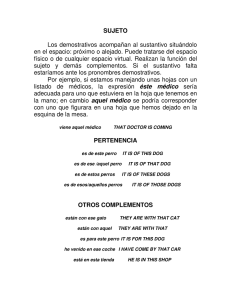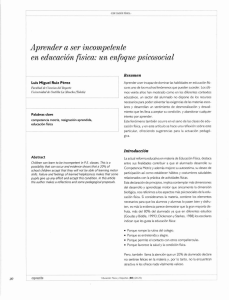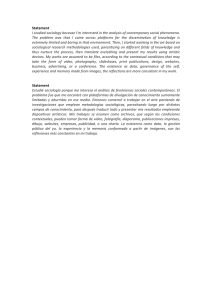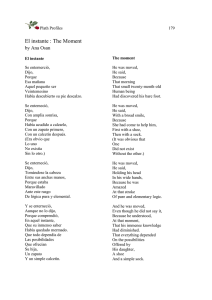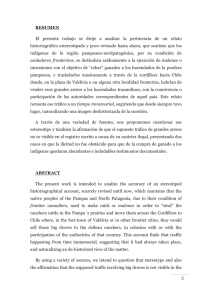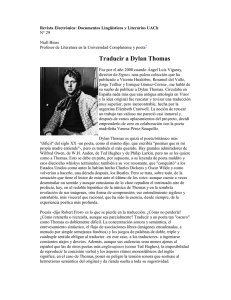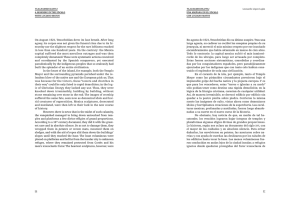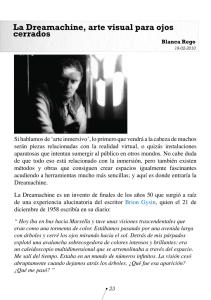"¿En qué estás trabajando ahora?". “What are you working on at the
Anuncio
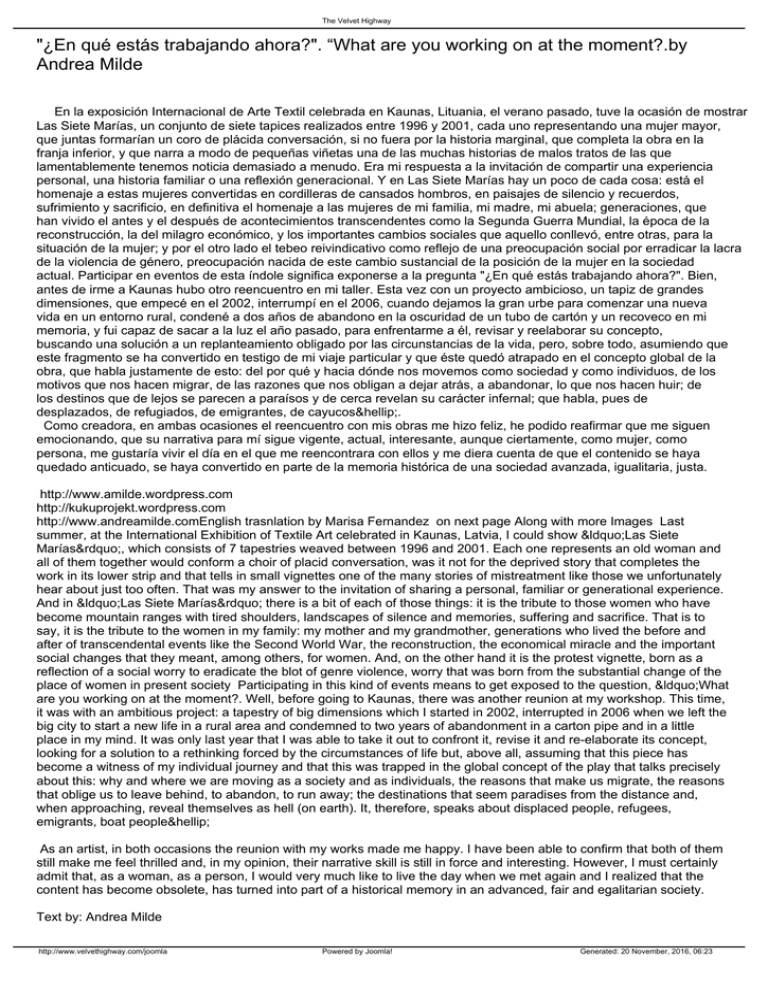
The Velvet Highway "¿En qué estás trabajando ahora?". “What are you working on at the moment?.by Andrea Milde En la exposición Internacional de Arte Textil celebrada en Kaunas, Lituania, el verano pasado, tuve la ocasión de mostrar Las Siete Marías, un conjunto de siete tapices realizados entre 1996 y 2001, cada uno representando una mujer mayor, que juntas formarían un coro de plácida conversación, si no fuera por la historia marginal, que completa la obra en la franja inferior, y que narra a modo de pequeñas viñetas una de las muchas historias de malos tratos de las que lamentablemente tenemos noticia demasiado a menudo. Era mi respuesta a la invitación de compartir una experiencia personal, una historia familiar o una reflexión generacional. Y en Las Siete Marías hay un poco de cada cosa: está el homenaje a estas mujeres convertidas en cordilleras de cansados hombros, en paisajes de silencio y recuerdos, sufrimiento y sacrificio, en definitiva el homenaje a las mujeres de mi familia, mi madre, mi abuela; generaciones, que han vivido el antes y el después de acontecimientos transcendentes como la Segunda Guerra Mundial, la época de la reconstrucción, la del milagro económico, y los importantes cambios sociales que aquello conllevó, entre otras, para la situación de la mujer; y por el otro lado el tebeo reivindicativo como reflejo de una preocupación social por erradicar la lacra de la violencia de género, preocupación nacida de este cambio sustancial de la posición de la mujer en la sociedad actual. Participar en eventos de esta índole significa exponerse a la pregunta "¿En qué estás trabajando ahora?". Bien, antes de irme a Kaunas hubo otro reencuentro en mi taller. Esta vez con un proyecto ambicioso, un tapiz de grandes dimensiones, que empecé en el 2002, interrumpí en el 2006, cuando dejamos la gran urbe para comenzar una nueva vida en un entorno rural, condené a dos años de abandono en la oscuridad de un tubo de cartón y un recoveco en mi memoria, y fui capaz de sacar a la luz el año pasado, para enfrentarme a él, revisar y reelaborar su concepto, buscando una solución a un replanteamiento obligado por las circunstancias de la vida, pero, sobre todo, asumiendo que este fragmento se ha convertido en testigo de mi viaje particular y que éste quedó atrapado en el concepto global de la obra, que habla justamente de esto: del por qué y hacia dónde nos movemos como sociedad y como individuos, de los motivos que nos hacen migrar, de las razones que nos obligan a dejar atrás, a abandonar, lo que nos hacen huir; de los destinos que de lejos se parecen a paraísos y de cerca revelan su carácter infernal; que habla, pues de desplazados, de refugiados, de emigrantes, de cayucos…. Como creadora, en ambas ocasiones el reencuentro con mis obras me hizo feliz, he podido reafirmar que me siguen emocionando, que su narrativa para mí sigue vigente, actual, interesante, aunque ciertamente, como mujer, como persona, me gustaría vivir el día en el que me reencontrara con ellos y me diera cuenta de que el contenido se haya quedado anticuado, se haya convertido en parte de la memoria histórica de una sociedad avanzada, igualitaria, justa. http://www.amilde.wordpress.com http://kukuprojekt.wordpress.com http://www.andreamilde.comEnglish trasnlation by Marisa Fernandez on next page Along with more Images Last summer, at the International Exhibition of Textile Art celebrated in Kaunas, Latvia, I could show “Las Siete Marías”, which consists of 7 tapestries weaved between 1996 and 2001. Each one represents an old woman and all of them together would conform a choir of placid conversation, was it not for the deprived story that completes the work in its lower strip and that tells in small vignettes one of the many stories of mistreatment like those we unfortunately hear about just too often. That was my answer to the invitation of sharing a personal, familiar or generational experience. And in “Las Siete Marías” there is a bit of each of those things: it is the tribute to those women who have become mountain ranges with tired shoulders, landscapes of silence and memories, suffering and sacrifice. That is to say, it is the tribute to the women in my family: my mother and my grandmother, generations who lived the before and after of transcendental events like the Second World War, the reconstruction, the economical miracle and the important social changes that they meant, among others, for women. And, on the other hand it is the protest vignette, born as a reflection of a social worry to eradicate the blot of genre violence, worry that was born from the substantial change of the place of women in present society Participating in this kind of events means to get exposed to the question, “What are you working on at the moment?. Well, before going to Kaunas, there was another reunion at my workshop. This time, it was with an ambitious project: a tapestry of big dimensions which I started in 2002, interrupted in 2006 when we left the big city to start a new life in a rural area and condemned to two years of abandonment in a carton pipe and in a little place in my mind. It was only last year that I was able to take it out to confront it, revise it and re-elaborate its concept, looking for a solution to a rethinking forced by the circumstances of life but, above all, assuming that this piece has become a witness of my individual journey and that this was trapped in the global concept of the play that talks precisely about this: why and where we are moving as a society and as individuals, the reasons that make us migrate, the reasons that oblige us to leave behind, to abandon, to run away; the destinations that seem paradises from the distance and, when approaching, reveal themselves as hell (on earth). It, therefore, speaks about displaced people, refugees, emigrants, boat people… As an artist, in both occasions the reunion with my works made me happy. I have been able to confirm that both of them still make me feel thrilled and, in my opinion, their narrative skill is still in force and interesting. However, I must certainly admit that, as a woman, as a person, I would very much like to live the day when we met again and I realized that the content has become obsolete, has turned into part of a historical memory in an advanced, fair and egalitarian society. Text by: Andrea Milde http://www.velvethighway.com/joomla Powered by Joomla! Generated: 20 November, 2016, 06:23 The Velvet Highway Translation by: Marisa Fernandez http://www.velvethighway.com/joomla Powered by Joomla! Generated: 20 November, 2016, 06:23

